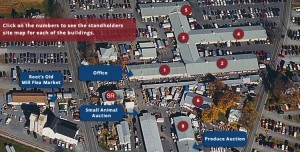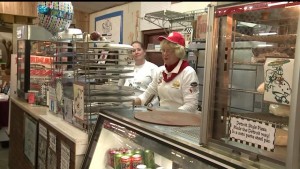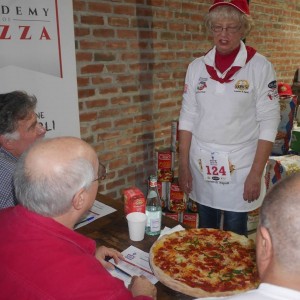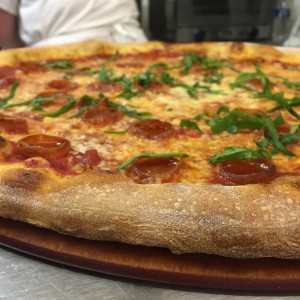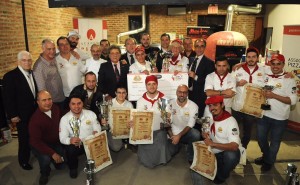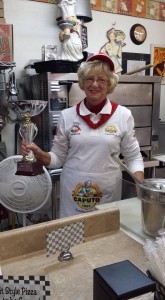Interview with Norma Knepp
–Norma, tell us a little about yourself and how you got into making pizzas.
I am 69 years old. I worked at RCA, GE and my then to be husband worked as a butcher, in addition to working part-time making caramel popcorn, kettle corn, old-fashioned clear toy candy, brittle, cotton candy, fudge and other kinds of popcorn at the Roots Farmers Market. My husband, Albert, wanted to quit his job as a butcher and try other farmer’s markets in our area besides Root’s Market. Albert’s parents started the Caramel Popcorn stand at Root’s Market in 1928. It was an 8′ stand when I met Albert. We later expanded that stand, and also went to other day farmer’s markets in our area. Albert had an unfortunate fall at home that led to many complications. I eventually sold those stands at the markets. I then purchased a Funnel Cake stand and sold fresh lemonade, fresh dipped ice cream, and even added Mexican food. I also made fresh salsas. Since the Funnel Cake stand was in the Flea Market section at Root’s (and was outside) it was only opened from March to the end of October. I knew the market management wanted a fresh pizza stand. Another man was going to start that stand. He had big equipment in the small space where I am located now. For some reason the man never finished the pizza stand. I asked the market management if I could sell fresh salsas, tortilla chips, dip mixes and such inside market, in addition to having the funnel cake stand. The fresh salsa stand never made enough money. I then asked market management if I could sell the funnel cake stand and try to make pizzas at the salsa stand. I didn’t know anything about making pizza when I started the pizza stand. My mother and I built out the pizza stand. It is only 8’x13′. I found the equipment on eBay and Craigslist. A local pizzeria man was going to help me learn how to make pizza dough but he became ill and had to be hospitalized. I already had joined the pizzamaking.com forum and was reading how many members there made pizzas, and how helpful the members were when someone had problems. At first I tried the dough recipe the pizza man gave me. It was in volume measurements, not by weight. The pizza man did not tell me anything about how to mix the pizza dough or how to control fermentation. I had many problems the first month, but was determined that I would learn to make pizzas. I started a thread and asked Pete-zza (his name is Peter, but not Peter Reinhart) for help. Pete guided me through many things until I could successfully make pizza dough and pizzas. He also directed me to many links from Tom Lehmann (“The Dough Doctor”). I asked questions on the PMQ think tank too. I have never stopped learning about pizza dough and I study things about pizza dough every day. I also have tested different kinds of pizza sauces, cheeses for pizzas and other toppings.
I got my inspiration for everything I learned from the pizzamaking.com forum and from the PMQ Think Tank, in addition to PMQ and Pizza Today, where I asked Tom Lehmann questions. I watched many YouTube videos, too, of professionals stretching their pizza dough. I’ve changed the formulation for my dough many times. Sometimes a preferment was used, old dough, longer ferments, and also different leavening methods were used. I even tried real milk Kefir as a leavening agent for awhile in experiments. I just learned by seeing what worked at the market. For a long while it was hard to get customers to come into the back area where I am. It is one of the slowest areas in the market. Since the market is so big most customers go on their regular routes and don’t stray from those routes. I knew from owning the Caramel Popcorn stand how many people went by there. Most of the time folks can’t walk very fast without bumping into one another. Where I’m located it’s not like that at all. The customers are sparse. I talked to the market management many times about how to get more people back to Area 4. For awhile I thought of selling my pizza stand and trying to find something else to do. I loved making pizzas, but wasn’t making any money. It’s hard to say how many pizza are made in a typical day. Usually in the winter months it’s slower. In the summertime there are a lot of people that only go to the outside stands. But now, since there has been a lot of media attention from the Caputo Cup win, I can’t keep up.
I never thought the pizza I made would have won first place, or any other place. My cheese clumped badly. I have photos of how badly it clumped. I grated the cheese the night before I was scheduled to compete. I put it in a Cambro container that wasn’t clear. About 15 minutes before I went to compete I saw how clumped it was from moisture that got in the container somehow. I tried to pick it apart, but had no idea of how much cheese I was applying. I had thinned my sauce some the night before competing. When I went to thin it more in the kitchen the two sinks were filled up with other contestants things. I then went out and got some Italian water to thin the sauce more. My hands were shaking so badly I didn’t think I would get through the competition. In the end I guess, because I have learned to balance ingredients to a certain point, that helped some. Also fermenting the dough overnight helped some.
I have learned that many experiments are needed to be able to make better than average pizzas. That balance of a good crust, about the right amount of sauce and cheese do matter. Also different oven and temperatures matter. The same dough and ingredients baked differently in the deck oven at Market than they do at the Caputo Cup. I also have a Blackstone pizza oven at home that I experiment with, making many types of pizzas. After much experimenting I can get exactly the same pizza that I can make at market from the Blackstone. Home pizza makers can make very good pizzas if they experiment some and follow a good dough formulation. I would say just keep striving to make the best pizza you can.
From Peter: As soon as I hear from Norma, I’ll let you all know right here how she did at the Expo competition in Las Vegas.
Recent Articles by Peter Reinhart
- “Tommy & Atticus” in Redondo Beach, CA. A Sourdough Success Story
- Howard Brownstein on Turnaround and Crisis Management
- Randy Clemens and Forest Farming in Uruguay — The Back to The Earth Movement is Back!
- It’s not too late to chase your dreams: “Pizza From the Heart” A New Book by Paulie and Mary Ann Gee
- Kyle Ahlgren on the Artisan Baking Center Online Classes (and a special offer)
- Multi-James Beard Nominee Cathy Whims of Portland’s Nostrana and her Brand New Book



